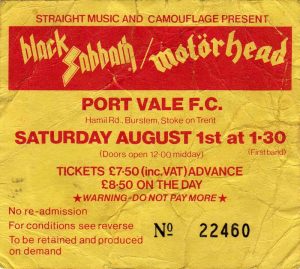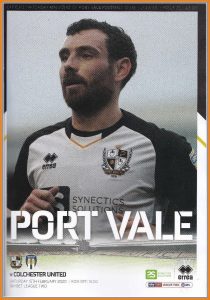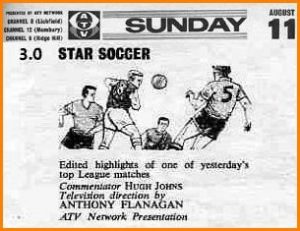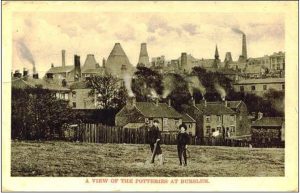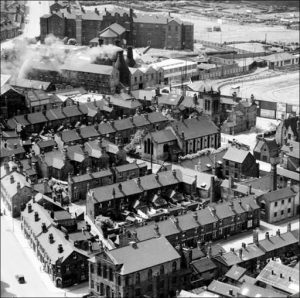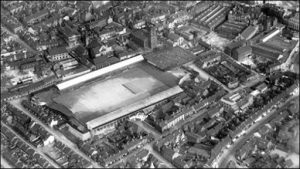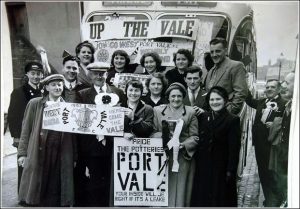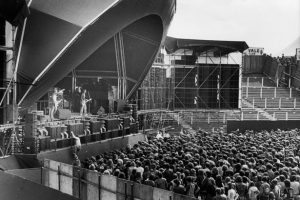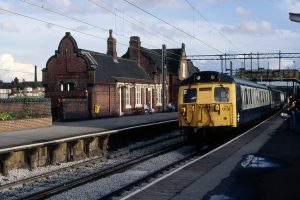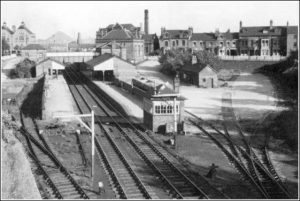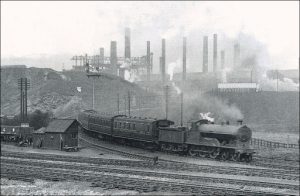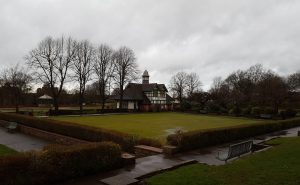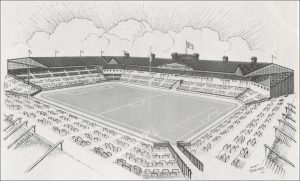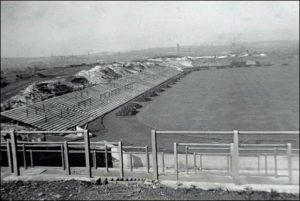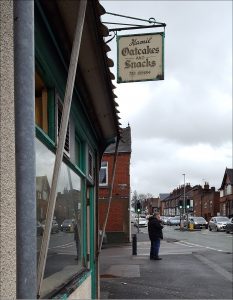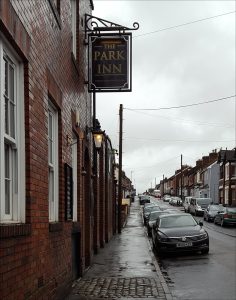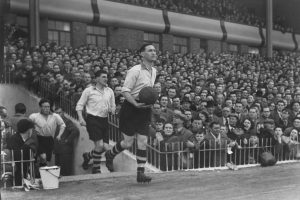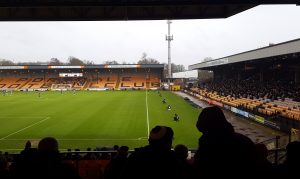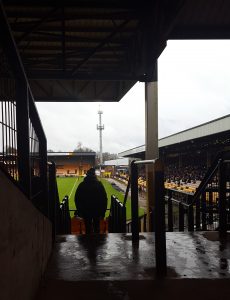Port Vale 3 Colchester United 0
League 2
Saturday 15 February 2020
The context
I lived in Wolverhampton during the early Nineties. My housemates included a rather scary girl whose even scarier boyfriend used to visit most weekends. They were both that irritating type of person whose dislike for football and lack of knowledge about it doesn’t stop them thinking they’re experts – and unfortunately for me they came from Tunstall, where by diabolical coincidence the local team had just embarked on the best season in their modern history.
John’s grudge is slightly more eclectic. He has a novel conspiracy theory that Vale were given undue exposure on regional TV during his childhood, muttering darkly about someone partisan working on the sports desk and claiming as a consequence to have grown up thinking the team were in Division One. Which to be fair is disconcerting in anybody’s book.
So were we looking forward to this trip? Well, actually yes. If we paid any heed to irrational prejudice we’d never go anywhere at all.
The history
This is the second Port Vale. Their forerunners, the more prosaic Burslem Port Vale, belonged to the Second Division for all except two seasons between 1892 and 1907. Although this League career was spent at the Athletic Ground in Cobridge they had four previous grounds and by 1885 had gravitated to Moorland Road, near the present Vale Park, after early years playing at Limekiln Lane, Longport and Westport. Financial collapse and liquidation followed before a new club were formed and elected to the League in 1919 (as plain Port Vale) following the expulsion of Leeds City for financial misdemeanours.
The ground at Cobridge outlasted Vale’s comparatively short stay by 70 years and staged community sport until sold for housing during the Eighties. A block of flats called Stadium Court now occupies the site. Its cinder track was used variously for cycling, athletics, greyhound racing and speedway, and generations of Stokies played football on the pitch. From 1913 onwards Vale based themselves at the Recreation Ground in Hanley. The Rec was a tight and atmospheric venue whose matchday crowd could be heard across the whole town.
By 1944, however, the ground was falling to pieces. It had been neglected during the War years and facilities were notoriously primitive – there were no toilets at all for the fans, and carrier pigeons lived in the main stand. To make matters worse Vale were faced with mounting debt and high rents. In the face of these difficulties chairman William Holdcroft conceived a grand scheme to move the club to Burslem. Their new home would have an enormous 80,000 capacity, a huge pitch good enough for representative matches and a quarter-mile running track. “No superior in this country”, said Holdcroft. The poor old Rec, meanwhile, was demolished and became the Potteries’ first pay-and-display car park.
Vale Park opened in 1950. It was soon packing in the fans as Freddie Steele’s young players narrowly missed the Division 3 (North) title in 1952-53 and went one better the following year. No doubt to the chagrin of strikers Basil Hayward and Ken Griffiths, the 1954 side became famous for a miserly back line that conceded a mere 5 goals at Vale Park and 21 overall (a Football League record to this day). This was the so-called Iron Curtain defence of Ray King, Stan Turner, Reg Potts, Albert Mullard, Tommy Cheadle and Roy Sproson. The team capped an extraordinary campaign by reaching the FA Cup semi-final.
The ground’s biggest crowd in recent times turned up for the Heavy Metal Holocaust festival in August 1981. This starred Ozzy Osbourne and Motorhead but was really all about one man – Motorhead’s Burslem-born frontman, Ian “Lemmy” Kilmister, It was in the record books for a while as the loudest rock concert ever. A high decibel count had been anticipated by local residents and their last-minute injunction almost caused the event to be cancelled. But organisers were one step ahead and cunningly bought off the protesters with an excursion to Blackpool on the day of the concert, thereby preventing them being Deaf Forever.
The journey
Back in those Wolverhampton days my girlfriend and I would often go to Vale if we had nothing better to do. The routine was an electric rattler to Longport station followed by a half-hour walk up the hill and through Burslem town centre. This pleasant stroll took us past the end of Port Vale Street, an ordinary-looking thoroughfare believed to be connected with the club’s birth. There’s no actual place called Port Vale and so speculation surrounds the nearby Port Vale canal wharf and corn mills, while the discovery of bricks marked “Port Vale” has led to suggestions the team originally represented a brickworks.
Had we been around in the Fifties we could have saved a lot of time by getting off the train in Burslem itself. The town’s station was on the much-missed Potteries Loop Line and stood in a cutting next to Burslem Park. The line continued to Cobridge in one direction and Tunstall in the other, passing near Vale Park en route. The ground’s westerly stand is known as the Railway Stand and a substantial stretch of trackbed survives to this day, mostly below street level, as a foot and cycle path between Sproson Park and Cobridge Park. The station site has been landscaped but the old station house can be seen next to the park lodge on Moorland Road.
Built between 1845 and 1875 by the North Staffordshire Railway Company and known locally as “the Knotty” because of the Staffordshire knot in its badge, the Loop Line served various steelworks, collieries and potteries around the seven small towns of Stoke-on-Trent. It also provided their residents with a direct passenger route to Manchester and London. The Knotty branched off at the now-vanished Etruria station and progressed in a rough semi-circle through Hanley. Cobridge, Burslem, Tunstall, Pitts Hill, Newchapel & Goldenhill before rejoining the main line just north of Kidsgrove. The route suffered from severe gradients and sharp curves due to Stoke’s hilly, industrialised landscape.
Today we went in our cars and met by the park. Other early arrivals were grabbing their spots, clumsily manoeuvring 4x4s in the narrow one-way street. There was a wild wind even though the rainy part of Storm Dennis hadn’t yet arrived. Sunshine poked through the clouds and municipal flowerbeds waited for spring.
The ground
Present-day Vale Park is a long way from Holdcroft’s bold 1950s vision. The vast terraced banks of the original design have been tamed into shallow all-seater stands. A capacity of 19,000 falls far short of the grandioise numbers it was planned to hold. And yet in some ways the ground remains true to the Wembley of the North concept – there’s tons of space beyond the touchlines of an already large pitch and behind the stands, where wide gangways are cut into the original, grassed-over banking. At the Bycars End you exit on steep paths among trees and bushes.
The ground’s first incarnation was a simple bowl with a pillared roof over the rear third of the Bycars. This was terraced from front to back and the Railway Stand, completed in 1953, featured seats behind a standing paddock. The Railway cover was intended to continue around both ends and the finishing touch would be an ornate grandstand. But funds ran out and the Hamil End remained open to the elements, while the Lorne Street side was left half-built with a small pavilion perched above a huge players’ tunnel. These temporary facilities remained in place for 40 years.
The frame of the Bycars had previously been part of the Swan Passage stand at the Recreation Ground. It dated from the 1920s and survived largely intact until the Taylor Report, when the entire end was re-roofed and converted into a substantial seated stand with a vast gloomy interior and shallow sightlines. The Railway Stand, meanwhile, retains its original structure but was refitted post-Taylor when seats were added to the paddock. A corner section between the Railway and the Bycars incorporates the last surviving girders from the Rec.
The Hamil End was the highest point of 1950s Vale Park. In those days it resembled a misshapen hillock but was later cut back into a more regular shape. This squared-off terrace eventually became the designated away end. In 1990 it gained a roof made from the recycled steelwork of the main stand at Chester City’s vacated Sealand Road ground. Seats were added soon afterwards – in common with most of Vale Park these are pale yellow and give the place a jaundiced appearance, which begs a very obvious question given that the team’s colours are and always have been black and white.
The final oddity is on Lorne Street. Here the all-seater age has succeeded simply in replacing one half-completed stand with another. This version’s been up 20 years and still isn’t finished, a long-standing lack of seats being the most obvious shortcoming. In fairness it does seem to gain a few more bits and pieces with each successive visit. The stand is big but has a low profile from the outside because the land falls away steeply towards Tunstall (the Hamil roof is at street level while the back of the Bycars is like the north face of the Eiger). A statue of Roy Sproson defends the main entrance with an iron casey welded to his manly forehead.
Flesh and wine
Vale Park is sometimes tricky for outsiders. But everything was quiet today and we wandered off happily in search of sustenance. This soon appeared in the shape of an oatcake shop where I imagined the lack of a queue would mean quick service. Instead I ended up watching possibly the slowest preparation routine in the history of pancake consumption, eventually emerging with a couple of sausage and cheese that kept me going during the short walk to the Park Inn.
Although the Park was apparently closed a practiced eye could spot the steady stream of fans that betray the rammed interior of a decent matchday boozer. And like the best of its kind there was no real distinction between fans and locals. Neighbourhood teams have always been a London thing and rarely seen in provincial cities. But Vale are cast firmly in the Millwall mould with supporters, wholly drawn from the surrounding area, who are fiercely loyal and occasionally over-zealous. And in its own quiet way the club gives them a lot in return.
For all the pub’s admirable qualities it didn’t grow on us and (having steadfastly refused to even look at an oatcake) John was hungry. So we decamped to the chippy on May Street – this was doing a less than roaring trade and displaying posters warning of a sausage price hike, but did manage to knock up a reasonable tray of chips and a couple of scallops. From here it was a quick stroll in the worsening rain to the old social club behind the Hamil End. Our route took us back past the oatcake shop where a queue snaking out of the door confirmed that demand had unsurprisingly outstripped capacity.
The club was busy but not packed. Drinkers were drinking while their children amused themselves by using the dance floor as a skidpan. Lots of League clubs used to have these establishments but they’re a dying breed now. This one is named after “wooden head” Tommy Cheadle, reputedly the toughest member of the Iron Curtain defence and a stalwart who racked up 333 appearances between 1946-57. It speaks volumes about Vale fans that their playing heroes are all right hard bastards.
The game
Sixth against seventh had draw written all over it. But the storm broke as kick-off approached and Colchester clearly weren’t up for a fight. Vale went ahead on the quarter hour, Tom Conlon scoring emphatically past Dean Gerken after Rhys Browne played him through. (At least that’s what it says here. I was in the trench-like urinals behind the Bycars at the time and “Yeah, he took it OK” was John’s expert analysis.)
There was some kind of kids’ go free deal and the concourse was crowded with ankle-snappers. A load were paraded around the pitch at half-time – due to the bad weather this perhaps gave them less pleasure than it might have done, but at least helped reduce the press around the pie stall. They were scarcely back in their seats before Mark Cullen pounced on Harry Pell’s fumblings for 2-0. Essex heads dropped still further and it was no surprise that Cullen added a third near the end from a dangerous Luke Joyce ball into the box.
It was more Iron Fist than Iron Curtain.
Teams and goals
Port Vale: Brown, Smith, Legge, Brisley, Montano, Burgess, Joyce, Conlon, Worrall, Cullen (Bennett 87), Browne. Unused subs: Oyeleke, Atkinson, Evans, Lloyd, Campbell-Gordon, Maddison.
Colchester: Gerken, Jackson, Eastman, Prosser, Bramall, Pell (Gambin 73), Comley (Norris 61), Senior (Poku 54), Stevenson, Nouble, Robinson. Unused subs: Ross, Sowunmi, Harriott, Clampin.
Goals: Conlon 14, Cullen 54, 72
Attendance: 5199.
